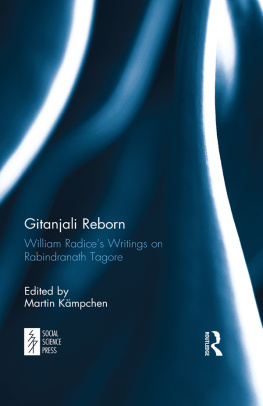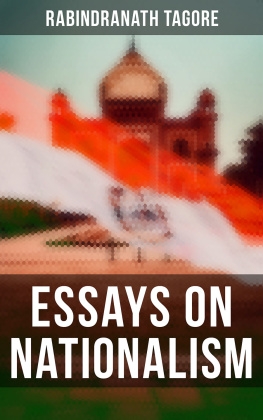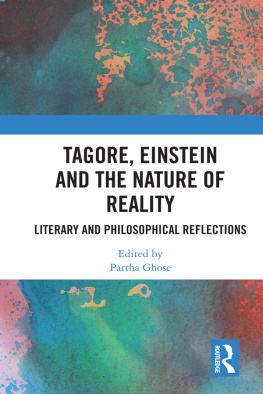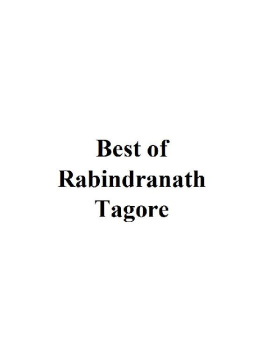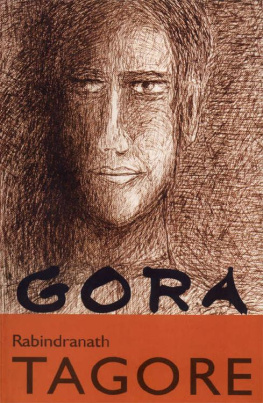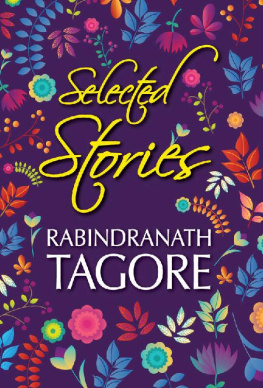
GITANJALI REBORN
GITANJALI REBORN
William Radices Writings on Rabindranath Tagore
Edited by
MARTIN KMPCHEN
First published 2018
by Routledge
2 Park Square, Milton Park, Abingdon, Oxon OX14 4RN
and by Routledge
711 Third Avenue, New York, NY 10017
Routledge is an imprint of the Taylor & Francis Group, an informa business
2018 selection and editorial matter, Martin Kmpchen; individual chapters, the contributors; and Social Science Press
The right of Martin Kmpchen to be identified as the author of the editorial material, and of the authors for their individual chapters, has been asserted in accordance with sections 77 and 78 of the Copyright, Designs and Patents Act 1988.
All rights reserved. No part of this book may be reprinted or reproduced or utilised in any form or by any electronic, mechanical, or other means, now known or hereafter invented, including photocopying and recording, or in any information storage or retrieval system, without permission in writing from the publishers.
Trademark notice: Product or corporate names may be trademarks or registered trademarks, and are used only for identification and explanation without intent to infringe.
Print edition not for sale in South Asia (India, Sri Lanka, Nepal,
Bangladesh, Afghanistan, Pakistan or Bhutan).
British Library Cataloguing in Publication Data
A catalogue record for this book is available from the British Library
Library of Congress Cataloging in Publication Data
A catalog record for this book has been requested
ISBN: 978-1-138-09954-8 (hbk)
ISBN: 978-1-315-14284-5 (ebk)
Typeset in Adobe Garamond Pro
by Manmohan Kumar, Delhi 110 035
To my dear wile Elizabeth, truest of guides.
William Radice
Contents
I n the years 2011 to 2014, Rabindranath Tagore celebrated a global presence not seen since his lifetime while his popularity was at its peak. The reason was three major anniversaries which followed each other in quick succession: Tagores 150th birth anniversary in 2011, the 100th anniversary of the publication of the English Gitanjali in 2012, and the 100th anniversary of the Nobel Prize in 2013. India and all countries connected with India globally felt obliged to make the best of this auspicious coincidence. Indeed, a multitude of conferences, seminars, festivals, performances were lined up. Rabindranaths books were republished, translated, films produced and exhibitions of his paintings held all over the world. There were a few peopleexperts and lovers of Rabindranath Tagorewho were riding the crest of such enormous activity. One of them was William Radice.
From 2010 to the later part of 2013 his presence in Tagore events became almost obligatory. He travelled through three continents tirelesslyAsia, Europe and Americato talk about his poet whom he had studied, translated, and lectured about, since four decades. Clearly, he became the western face of Tagore scholarship and of Tagore values. Like Rabindranath went around the world to spread the message of peace and international understanding in the years between the two World Wars, so William Radice travelled tirelessly to spread his love and fascination for Tagore. The same missionary enthusiasm! I believe, William did not refuse a single invitation if the dates did not clash.
He is singularly equipped for such discipleship. He had learnt Bengali as a young man in London and started to read Rabindranaths poems soon after being able to read Bengali at all. Being a poet himself, he succumbed to the urge of translating Rabindranath almost immediately. With translating Tagores poetry, William found his true fulfillment as a poet and creative person, although he has produced not less than ten volumes of his own poetry to date. William Radice became Lecturer of Bengali at London University which gave him the opportunity to share his knowledge and love for the poet with his students. The watershed event was however the publication of his Selected Poems of Rabindranath Tagore by Penguin Books UK in 1985.
All of a sudden Tagore rose from the proverbial ashes like a phoenix. Besides Rabindranaths own well-known prose versions of his Bengali poetry, there had been other translations in English, mostly by well-meaning and scholarly followers and associates. They were in prose, many inaccurate, rather condensed versions of the originals and not reflecting their literary greatness. Now here was a man, a poet himself, who transformed Rabindranaths poems into English poems and still was philologically accurate. William told the world that poetic magic can be translated.
Ever since the Selected Poems went into several editions, from 1995, including in India, it became the object of discussion, praise, criticism and gave rise to other, similarly worthy, translations by others. Just as Tagore appeared on the global scene with one single book, Gitanjali, so he was resurrected, for non-Bengali readers, by one single book, the Selected Poems. William Radice later translated a selection of Tagores short stories, his short, aphoristic poems, two plays, and finally his Bengali Gitanjali. We will read a great deal about Williams elaborate tour de force in this collection.
William Radices Gitanjali translation appeared in 2011, in time for the birth-anniversary celebrations. William rightly felt that he was successful in analysing and exposing the poet W. B. Yeats considerable flaws in the editing of the English Gitanjali. He was able to prove that Yeats had revised Tagores Gitanjali manuscript in such a way that it, to a considerable extent, falsified Tagores deeper inspirations and intentions.
In the years 2011 to 2013, William Radice travelled from event to event to declare the damage caused by Yeats revision of the English Gitanjali and to explain how he, in his new book, has been able to demonstrate the true greatness of the Indian poet by reconstructing the original manuscript and offering his own modern verse translation. In our collection of lectures we will see him returning to this book in almost every text.
Radices translation of Gitanjali is without doubt a great contribution to literature, to Tagore literature in particular. Yet it remains conspicuous by the silence which still surrounds it.
In this collection we witness William Radice at his best. He transcends his scholarship and dares to become personal and emotional. His oratorical powers are used to declare his love and admiration for Rabindranath, especially his poems and songs. We have the William Radice who speaks up, gives evidence, tries to convince and collect fellow admirers. Observe how his fertile mind throws up new ideas on Rabindranath, new perspectives and points to ponder on in every single lecture! Self-possessed as poets tend to be, he reveals how Rabindranath Tagore has possessed him all along. In 2011, William Radice turned 60 years, and appropriately these lectures were an opportunity for him to take stock, to look back at what he had accomplished.
In May 2013, he met with an accident from which he has recovered admirably. But he has chosen, for the time being, to lead a retired and somewhat reclusive life with his family in England.
Next page
